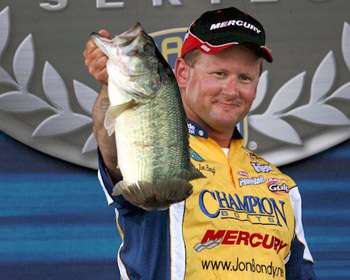
For bass anglers living in the northern part of the United States and Canada, winter is a time to reflect on the past season, organize tackle, and wait for the spring thaw.
But fishermen in warmer regions refuse to give up on bass fishing, despite the blustery weather. Even on days so cold they have to dip their rod tips in the water to melt ice crystals, these cold weather warriors know there's at least one lure they can rely on to load the boat with bass: a jigging spoon.
As the only Canadian on the Bassmaster Elite Series, Jon Bondy knows how to catch cold water bass. One of his baits of choice when fishing in frigid water is the jigging spoon. "Throughout the country, the best time to fish a jigging spoon is during the dead of winter, in the coldest water of the year," explains the Ontario pro.
Bondy's search for cold water bass takes him to deep water structure. The depth, of course, depends on the lake he's fishing. "At Table Rock Lake (Mo.), the fish will be really deep, but in an Alabama lake, they might be in only 20 feet of water. Out in California, I've heard of people catching them 100 foot deep on jigging spoons."
As a rule, when fishing in the eastern half of the country, he targets the 20- to 60-foot depth range. Catching sluggish bass that are unwilling to chase a lure can be daunting for any angler, but Bondy explains how to increase your success this time of year.
The key is finding groups of bass and taking advantage of the active ones. "If you're going after deep spoon bass, you're just hoping that some fish in the pod will actually feed," he says. "If you find some activity on the graph, there's probably more than a few bass there. If you have 20 bass there, 18 of them won't be feeding but two of them might be.
"This time of year, it could be either a reaction or a feeding bite. Bass are cold blooded so they are not very active, and the amount of food they digest is dependent on the water temperature. They don't eat very often because it takes the bass a long time to digest the meal in such cold water." Bondy's jigging spoon retrieve involves dropping the spoon into the school of bass and then snapping his rod tip upwards 12 to 24 inches. "The upward snap is what attracts the bass, but they will hit the spoon as it starts to fall," explains Bondy.
He lets the spoon fall on a tight line in order to feel the light bite. "If you don't let it fall on a tight line, you won't feel the subtle bite." When you start to lift the spoon again, you'll learn that a fish has already grabbed it, and you won't be able to get a good hook set, he says.
While he most often utilizes the standard vertical jigging spoon presentation, there are times when Bondy scores by casting the jigging spoon and working it back in a series of short hops. Once again, he stresses the importance of keeping a semi-taut line at all times to feel subtle bites while the spoon is falling.
Bondy lets the conditions and baitfish in the area determine the size, weight and color of his jigging spoon. He most typically uses a 1/2-ounce to 3/4-ounce spoon but occasionally drops to a 1/4-ounce lure when using a cast-and-hop retrieve. On cloudy or overcast days, he uses a gold or painted spoon, and on sunny days, he reaches for a chrome or white spoon. "I'd say that 99.9 percent of the spoons on the market come with a mediocre hook," he suggests. "What you have to do is find a good quality extra wide gap treble hook and add a stainless steel split ring," he explains.
Bondy also modifies the spoon's body to make it dart and fall like the dying baitfish it imitates. "I like to file down the spoon at each end so it's just wide enough to slide a split ring through the hole at the top and bottom. By thinning down each end of the spoon, adding split rings, and using a quality hook, you will improve your catch." Bondy also stresses the importance of using the proper tackle when using a jigging spoon. "I use 10-pound Berkley fluorocarbon line with a 6-foot, 9-inch All Star rod with a fast tip. I want a rod that's light but still has a sharp tip. The rod has to have some give once the fish gets up to the top because they can throw the spoon quite easily if they jump."
(Provided by Z3 Media)




